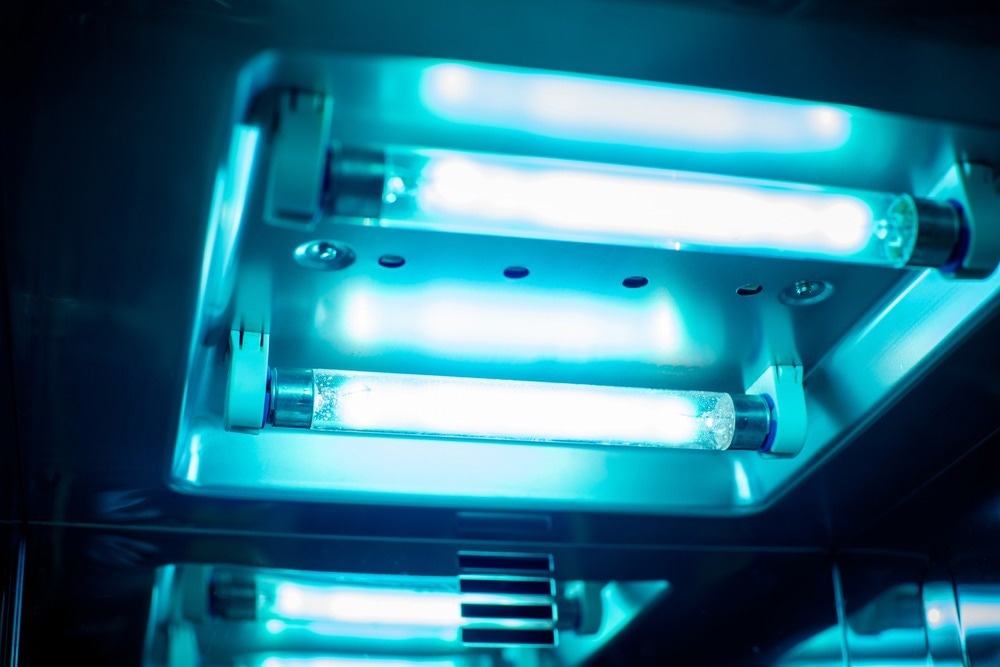In a recent study posted to the bioRxiv* preprint server, researchers assessed the real-time inactivation of severe acute respiratory syndrome coronavirus 2 (SARS-CoV-2) using ultraviolet-C.
 Study: Real-time inactivation of airborne SARS-CoV-2 using ultraviolet-C. Image Credit: Nor Gal/Shutterstock
Study: Real-time inactivation of airborne SARS-CoV-2 using ultraviolet-C. Image Credit: Nor Gal/Shutterstock
Background
As a result of many waves of outbreaks, the coronavirus disease 2019 (COVID-19) pandemic has severely disrupted human health, societies, and healthcare systems worldwide. The introduction of more contagious SARS-CoV-2 variants and COVID-19-related long-term health issues continue to have a negative impact on the global economy and health despite the fact that vaccinations and public health precautions have significantly reduced the risk of serious COVID-19 outcomes.
An infection prevention technique known as upper-room germicidal ultraviolet-C (UR GUV) irradiation, first used to inactivate airborne Mycobacterium tuberculosis, has since been widely used during COVID-19. There are still concerns about the practical effectiveness of UR GUV fixtures despite major scientific improvements in the area because there is presently no accepted Environmental Protection Agency (EPA) technique for assessing the effectiveness of UV-C against airborne infections.
About the study
A patient room-sized chamber was used in this investigation to test the effectiveness of UR GUV devices against large quantities of live viral aerosols. SARS-CoV-2 was used as the challenge organism.
According to Biosafety Level 3 (BSL3) requirements, testing was performed in a sealed 20'x8'x8' chamber. The test chamber's overall dimensions produced an air displacement volume of roughly 36,245.56 liters, exceeding the EPA's recommended room size and simulating real-world testing of disinfection systems against aerosolized bacteria. The center of the 20-foot wall included a nebulizing port that protruded 24 inches from the wall and was coupled with a programmable compressor system.
Four air sampling probes were installed in the room; each placed six feet off the chamber floor and in the middle of the space. At the center of one of the eight-foot walls, roughly 6.5 feet off the ground, was mounted a UR GUV device with 48 light-emitting diodes emitting from the light source.
To produce bioaerosol, a Blaustein Atomizing Module (BLAM) having preset pounds per square inch (PSI) along with a computer-controlled liquid delivery system was evaluated for average particle size distribution. The team placed 7.04 x 106 median tissue culture infectious dose (TCID50)/mL of SARS-CoV-2 in a viral suspension media in the nebulizer, and untreated local atmospheric air was nebulized at a flow rate of 1 mL/min. The residual viral stock volume in the nebulizer was weighed after nebulization to ensure that roughly the same volume was nebulized for each of the three replicate runs. Four air sampling probes, each linked to a calibrated Gilian 10i vacuum device and set to a standard flow of 5.02 L/min with a tolerance of 0.20%, were used to collect bioaerosol samples at zero, five, 15, and 30 minutes.
For each time point, sample collection volumes were adjusted to ten-minute draws, allowing for roughly 50 liters of air collection per collection port. The collection of air samples was restricted to ten-minute intervals. To calculate a mean across the four sampling sites, all sample discs were combined into a single collection tube. The UR GUV device was then operated in the same manner with appropriate time points and collection rates following the control runs. Utilizing the TCID50 approach, the viral suspensions from treated and control discs were measured.
Results
The study findings showed that control demonstrated a meaningful recovery after a natural viability reduction of aerosolized SARS-CoV-2 for 30 minutes inside the chamber under controlled conditions. After five minutes of device operation, the initial concentration of 7.04 x 106 TCID50/mL for three tests against SARS-CoV-2 was lowered to 4.55 x 106, 4.72 x 106, and 4.25 x 106 TCID50/mL, averaging to about 4.51 x 106 TCID50/mL.
The device decreased the collected SARS-CoV-2 after 15 minutes to 1.25 x 106, 9.86 x 105, and 7.47 x 105, with an average of about 9.93 x 105 TCID50/mL. Approximately 30 minutes after, the collected SARS-CoV-2 reduced to 4.80 x 102, 1.20 x 102, and 1.20 x 102, average 2.40 x 102 TCID50/mL.
Conclusion
Overall, the study findings demonstrated a robust aerosol testing protocol which showed that the tested device was highly effective against airborne SARS-CoV-2. The researchers believe that this study protocol can be used as a reference by manufacturers and infection preventionists to assess the effectiveness of other UR GUV technologies.